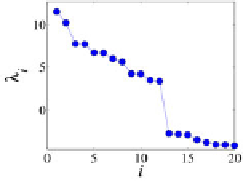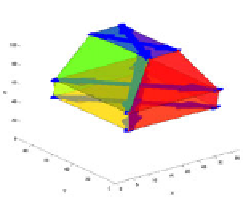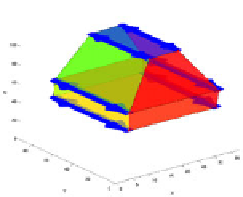Information Technology Reference
In-Depth Information
Fig. 13, while the rest of the face images with the detected symmetry axes are de-
picted in the Supplementary Materials.
Loy and Eklundh [LE06] report an accuracy of 95.1%, where they detected up
to
five
symmetry axes per image and considered the symmetry analysis success-
ful if
anyone
of those was accurate. To emphasize the applicability of our scheme,
we only detected a
single
reflection axis, and applied the generic formulation de-
tailed in Section 4.2. Further accuracy could have been derived, by recalling that
the symmetry of faces is strictly reflectional. Hence, we can tune the SSA to de-
tect only reflectional symmetries by allowing a feature point to be matched only to
descriptors of reflected feature points. Recall that in Section 4.2.1 we added those
reflected feature points, as image descriptors (SIFTs in this example) are not reflec-
tion invariant. In practice, the symmetry analysis acts as a interest point detector of
face-specific features, as those are symmetric.
5.3
Analysis of Three-Dimensional Symmetry
The SSA can be readily applied to three-dimensional objects. For instance, applying
it to mesh objects would entail the use of the equivalent of local features in meshes.
While it is clearly feasible, it is beyond the scope of this work, and we restrict the
discussion to the analysis of a symmetric mesh object without any mesh-oriented
local features. As such we analyze the mesh in Fig. 15, which depicts a rectangu-
(a)
(b)
(c)
(d)
Fig. 15
Three-dimensional symmetry.
(
a
)
The spectral alignment eigenvalues
(
b
)
Self-
correspondence by
λ
2
- rotation
(
c
)
Self-correspondence by
λ
3
- reflection
(
d
)
Self-
correspondence by λ
4
- reflection








Search WWH ::

Custom Search